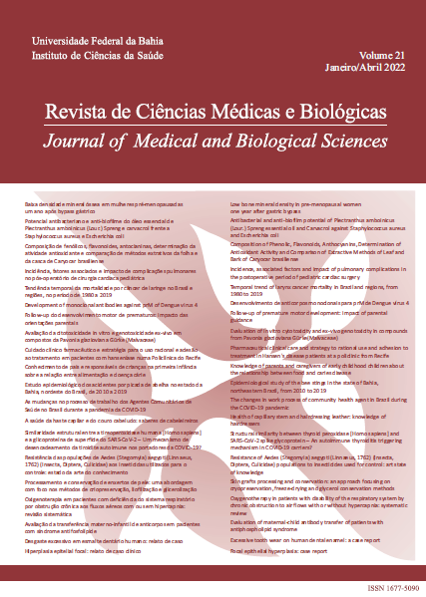Antibacterial and anti-biofilm potential of Plectranthus amboinicus (Lour.) Spreng essential oil and Carvacrol against Staphylococcus aureus and Escherichia coli
DOI:
https://doi.org/10.9771/cmbio.v21i1.46686Keywords:
Biofilm, volatil oil, natural productAbstract
Introduction: S. aureus and E. coli are pathogen that can cause persistent infections due to antibiotic resistance mechanisms and to its ability to adhere and form biofilm.The search for new agents from natural resources to counter microbial biofilm is an urgent priority in healthcare. Objetive: Chemical composition and antibacterial and anti-biofilm activity of Plectranthus amboinicus essential oil (PAEO) and of carvacrol were investigated against Escherichia coli and Staphylococcus aureus. Methodology: PAEO chemical analysis was performed by gas chromatography coupled to a mass spectrometer. Antimicrobial activity was assessed by disc diffusion method and broth microdilution method to determine minimum inhibitory concentrations (MICs). Antibiofilm activities were investigated using 96-well plates with crystal violet assay. Results: Carvacrol (85.25%) was the major component in the PAEO. According to disc diffusion test the ability of PAEO and carvacrol for inhibition of bacteria in planktonic form was confirmed. Minimum inhibitory concentration (MIC) of PAEO for S. aureus and E. coli were 0.31 and 1.25%, respectively, with bactericidal effect. Carvacrol demonstrated a significant antibacterial property (MIC = 0.31%), exhibiting bacteriostatic effect against S. aureus and bactericidal effect against E. coli. Carvacrol significantly inhibited the formation of E. coli biofilm (58.9%). Moreover, carvacrol inactivated a mature biofilm. Conclusion: The data obtained are promising, making it possible to develop new therapeutic alternatives. These results denote the potentiality of carvacrol as a source for the treatment of diseases caused by E. coli and S. aureus.
Downloads
Downloads
Published
How to Cite
Issue
Section
License
Copyright (c) 2022 Journal of Medical and Biological Sciences

This work is licensed under a Creative Commons Attribution 4.0 International License.
The Journal of Medical and Biological Sciences reserves all copyrights of published works, including translations, allowing, however, their subsequent reproduction as transcription, with proper citation of source, through the Creative Commons license. The periodical has free and free access.


